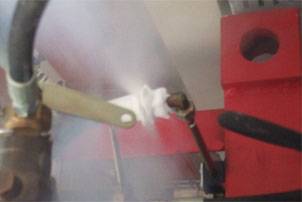Simple Failures Render CO2 System Inoperative
The following U.S. Coast Guard safety alert addresses concerns discovered during an ongoing marine casualty investigation and may be of interest to ship builders, classification societies, owner / operators and others involved with vessel operations.
A machinery space fire onboard a relatively new vessel was effectively responded to and extinguished by the vessel’s quick response team firefighters using portable extinguishing equipment. However, before it was declared completely extinguished and approximately five hours after the fire started, the master of the vessel made the decision to release CO2 from the vessel’s fixed firefighting system. It failed to operate as designed. Subsequently, crewmembers were unable to activate it manually and CO2 was never directed into the machinery space.
The following issues pertaining to the CO2 system were discovered:
• Numerous piping and hose connections leaked extensively. When the system was activated, on scene video taken by the firefighters showed numerous leakages into the CO2 room. Post casualty, while pressure was still on the system, some of these leaks continued even after the connections were tightened.
• The zone valve for the aft machinery space which admits CO2 from the bottle bank manifold to the space failed. Specifically, the ball valve’s opening actuating arm fell off the valve when the gas powered piston actuator attempted to move it. The ball valve actuating arm was held in place by a very small machine screw and washer. When firefighters attempted to open the valve manually using the provided hardware it could not be moved. The valve was only able to be moved after the gas pressure was relieved from the inlet side of the valve.
• Actuating arms to five of the six other zone valves were found loose. They were also attached by
small machine screws.
• Hemp type pipe sealant was used extensively on pipe threads throughout the system and in some instances seems to have entered the system.
• Certain elements of the distribution manifold contained low points which allowed the accumulation of water within piping that could not be drained. Such a circumstance could cause corrosion that could possibly negatively effect operation of other components.
• The CO2 system’s pilot and co-pilot bottles did not appear to operate correctly according to the firefighters involved and thus had to be manually activated using the valve handles located on top of the cylinders. Additionally, during the event, the bank bottles were similarly activated due to the uncertainty of their release. At least one pilot bottle activation hose was reported to have leaked.
• The system had been recently serviced and inspected by an authorized service provider. Because of these and other issues, the United States Coast Guard strongly recommends that vessel builders / shipyards, classification societies, insurers, owners / operators, system service personnel, and others involved with these systems:
• Carefully and critically review, routinely inspect and maintain, verify and test their Fixed Fire Fighting installations to ensure that they will operate correctly during an emergency.
Developed by the U.S. Coast Guard Headquarter’s Office of Investigations and Analysis, Washington,
DC. Questions may be addressed to [email protected].

















